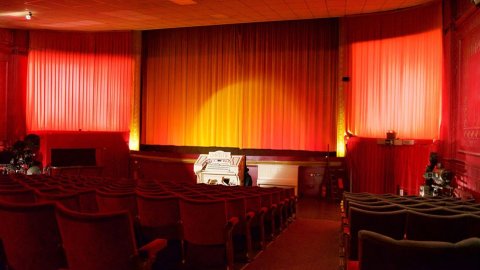
Tara Judah
on Mon 11 July 2016The Art of Cinema-Going
Posted on Mon 11 July 2016
Cinema-going still exists and in it is a craftsmanship all its own; an experience that is both immersive and cognitive, one that presents and presumes a combination of surrendering and activism in viewing.
Cinema-going is not the same as consuming content. Busy lives dictate that time is scarce and scarcity holds value. But increasingly, people watch films on their smart phones and various devices; at the gym, on public transport, in the home and, as I’ve even heard, in the bathtub. The viewing experience, then, becomes another form of consumer culture; we digest the content of film as if the sound and picture quality were of little importance. But cinema-going still exists and in it is a craftsmanship all its own; an experience that is both immersive and cognitive, one that presents and presumes a combination of surrendering and activism in viewing.
At home, or on the go, we have the opportunity to pause, stop, mute, freeze-frame, rewind, fast-forward, skip and fundamentally change the viewing experience. In the auditorium, a highly skilled and trained projectionist – both a sound engineer and a showperson – hides in shadow, manipulating the settings, shifting focus when required, masking to the picture’s edge, tweaking the sound so that it’s just right for both score and dialogue, lowering the house lights at exactly the right moment, ensuring the running order of slides, advertisements and trailers is just right for the picture that follows.
But, I hear the purists cry, this experience is dead, we have lost this with the transition from film to digital. Not so. A digital presentation still requires a running order, only it's called a playlist. The picture must still be masked and the sound settings set. The same Midas Touch is required to set the house lights and to create an atmosphere in the auditorium when you enter – the ambient music that is set for your reception.
There is craft in putting on a show, whatever that show may be. Even down to the rubbish bins and toilet cubicles – any venue concerned with visitor experience will ensure you don’t notice these details: no bin will ever be full and no cubicle without paper. These may sound like fastidious details, but they are, cumulatively, what takes away the pressures of everyday life from the viewer, temporarily removing the entire world of external concern. When we watch at home we are responsible for the cleanliness of our own environment, and noticing the dirt on the skirting boards behind your speakers might distract you from engaging completely with the film. In the cinema someone else has taken care of every speck of dust, every possible element that could effect your experience. You are not in control and it's simply wonderful.
For me it is clear that cinema-makers are artists. Their art is in ensuring you can give yourself to the experience from the moment you step through the front doors, right up until the moment you leave the venue. The world’s concerns, your mounting laundry and unanswered emails simply melt away. Cinema-going is about surrendering yourself to the screen so you can make a connection, and actively participate in engaging with an artform, free from interruption.
This is not to say that there is anything wrong with watching films in a multitude of ways and, certainly, it is true that the most available viewing options are not always cinematic. But, for the love of repertory and archive film, there is yet a chance to view art within art, an opportunity to see cinema redisplayed on the big screen, shown with care and precision so that it may be enjoyed as it was intended to be seen: as a shared experience, in the dark, in that dedicated cinematic space we call an auditorium.
Image of Curzon Cinema & Arts, Clevedon.
